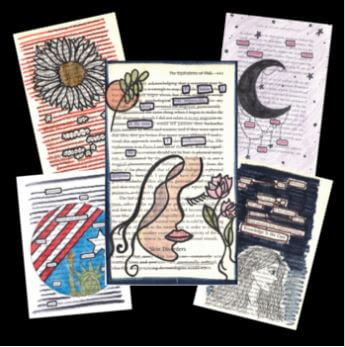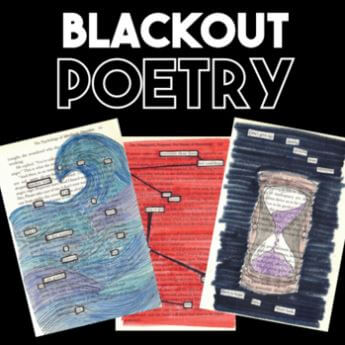Teaching blackout poetry is an engaging way to help spruce up your poetry unit. Show a few examples, and your students will be eager to create a blackout masterpiece of their own. Keep reading to learn what blackout poetry is and just what you need to do to teach it.
So, you’re thinking about teaching blackout poetry, huh? (You totally should.)
I look forward to teaching blackout poetry every year. But it’s not just me. Blackout poetry is an activity my students love too. Can we do that again sometime? They ask. (My heart skips a beat.)
From one teacher to another, I know the last thing you need is to add something else to your overflowing plate. Luckily, blackout poetry can add a lot to your classroom without much work on your end. You just need some simple materials and a few steps, and voila! Your students will be on their way to creating poetic masterpieces.
What Is Blackout Poetry?
At its core, blackout poetry is a type of found poem that encourages students to create poetry from larger texts. It works by students carefully selecting words and phrases from texts ranging from newspapers, magazines, novels, and other printed texts to create a poem. Then, they black the rest of the text out.
The end result? Unique poems that emphasize a theme or emotion in the original text or take on a whole new meaning altogether! Safe to say, teaching blackout poetry is my teaching poetry analysis go-to.
Why I Love Teaching Blackout Poetry (And Why You Will Too).
Blackout poetry can turn into a piece of poetic and visual art. Visual learners and artistically inclined students are bound to love this creative opportunity. Some will enjoy the challenge of finding the poems “hidden” on the page. Others will just be glad they don’t have to come up with the words themselves. Regardless of which category a student falls into, they’re often pleasantly surprised with their final product. (You will be too!)
Teaching blackout poetry is a unique opportunity to get students thinking about popular poetic devices. Thanks to the need for students to carefully select words from the page, blackout poetry gets them looking at the words with a more critical (and creative) eye. As they determine which words they’ll use in their poem, they must consider diction, tone, theme, and imagery. You can encourage them to employ poetic devices such as figurative language, symbolism, metaphors, similes, hyperbole, and rhythm.
Trust me. Blackout poetry is far more than selecting random words on a page and ignoring the rest. This poetic form requires students to interact closely with the text and derive new meaning. And that’s what I love about teaching it; it’s a unique opportunity for students to explore and express poetry.
Teaching Blackout Poetry: A Step By Step Guide
HERE’S WHAT YOU NEED.
No intense planning or last-minute runs to Target required. Instead, teaching blackout poetry can be as simple as you want it to be. All you need for your students’ success are pencils, black markers (Sharpies deliver the best results IMO), and pages of text that students can repurpose. Want students to dig deeper and get more creative? Provide art supplies like paint, colorful markers, colored pencils, or crayons.
What specific text to use is up to you, my friend. If you’re looking for an activity during a poetry unit that encourages students to interact closely with words and play with meaning and form, you can have students bring in their own text. Encourage students to bring in a school-appropriate book, magazine, or even song lyrics a day or two before you plan on doing the activity. Ask them to mark a few of their favorite pages so you can photocopy them.
Alternatively, if you are currently reading a novel or just finished one as a class, encourage students to complete the activity using a handful of preselected (and photocopied) pages to create their poem! It’s a creative way for students to see the various poems, interpretations, and perspectives that can come from the same text.
HERE’S WHAT YOU DO.
I always begin with a brief introduction of found poetry and a few examples. Consider sharing Austin Kleon’s Newspaper Blackout Poems. (There are some great examples there too!) Due to the unique nature of this poetic form, it’s helpful for students to see examples before they tackle it themselves. Then, simply share these five steps with your students and watch their poetic creativity unfold.
THE FIRST STEPS IN TEACHING BLACKOUT POETRY.
Step 1: Have students scan the text, looking for anchor words. These are the impactful words that jump off the page. These will be used to “anchor” their poems and their themes. They’ll want to circle these words lightly with a pencil. It’s helpful to remind students to not focus profoundly on reading the text, but rather just focus on the words, phrases, or general themes that jump out to them.
Psst… it helps to remind students to skim the page from top to bottom and left to right. They can’t change the order of the words on the page when they’re creating their poem.
Step 2: Students should write out the words and phrases on a separate paper in the order they appear on the page. This is an important step because the rest of the words can be a big distraction when students are trying to decipher the meaning and finalize their word choice.It might not look like a poem yet, but remind them it’s all part of the process.
Step 3: Next, students will read through their list and circle their favorite words and cross out the rest. Remind them that the words should flow together to express an idea, create an image, or develop a theme. (If needed, they can rescan the text for “missing” or “connecting” words that might help solidify their idea or increase the flow.) Before moving on to the next step, encourage students to read the selected words aloud and consult their peers if they wish. I love hearing them complement each other’s work or give constructive advice!
Step 4: Students will solidify their poem by going back to the page of text and finalizing their word choice and, therefore, poem. They will carefully outline their final selection of words with a black marker. Be sure to remind them not to rush through this part. Afterall, you cant erase marker!
Step 5: Use the marker to blackout all of the unused words. Yup. It’s as simple as that. However, if you’re looking for a way to bring the poems to life, add the step below. Imagery and poetry go hand in hand, right? Keep reading to learn how students can incorporate visual elements into their blackout poems.
The ART of Teaching Blackout Poetry
Blackout poetry can be just that – a poem with the rest of the words on the page blacked out. However, that misses a huge opportunity for student creativity and critical thought. That’s where the element of art comes into play.
I always require students to include an artistic visual element with their blackout poem. Instead of grading students on their artistic ability, I consider how the art supports the poem by illustrating or adding to its overall meaning. Some students create epic visual representations of their poetry while others sketch some simple drawings or designs. Either way, this element adds some level of depth to the poem itself.
So, once students have their chosen words circled, ask them to think of a way to represent the theme or imagery of the poem visually. Then, before they take a sharpie to paper, have them sketch over their “throwaway” words using a pencil. Once they are satisfied with their design, they can begin outlining, adding color, and really bringing their poem to life.
Show off Their Work
In my experience, students are always excited to share what they did. So, be sure to showcase your students’ masterpieces. You can minimize the pressure of sharing by doing a gallery walk or simply decorating your classroom walls with their poetic art.

A Note on Grading Blackout Poetry
Could you grade this activity based on completion? Sure. However, blackout poetry is an excellent opportunity to assess students’ ability to dig a little deeper. Therefore, I grade blackout poetry using a simple rubric or a student reflection. Whichever way you divide to go, here are some elements you can consider:
- Is there a clear and well-developed theme in the poem?
- Is the theme supported by appropriate tone and diction?
- Does the word choice create powerful images and elicit emotion for the reader?
- How do the artistic elements complement, highlight, or develop the poem?
While I never grade based on artistic ability, I always include an element of neatness, use of markers, and color or shading. You can also give students a word count range or a limit on consecutive words to provide more guidance and prevent regurgitation of what is already on the page.
That’s a wrap! Now it’s time to bring the magic of blackout poetry to your classroom. Just bookmark my Beginner’s Guide to Teaching Blackout Poetry to reference as needed. And while you’re at it, share it with your teacher friends! Chances are, they’ll be eager to introduce this form of poetry into their classrooms too.
Just be warned. Once you’ve experienced blackout poetry, you might have a hard time not finding poems hidden on the page when you read. (Challenge accepted.)

